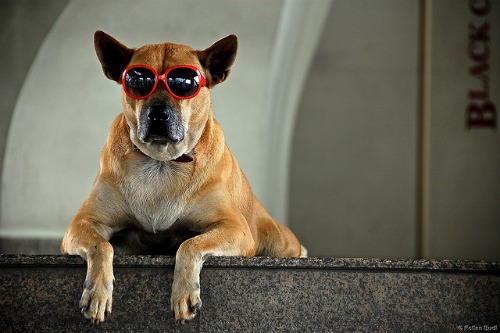Send your question to Umbra!
Q. Dear Umbra,
I liked the article on pedestrian-friendly cities, but what I really want to know about is dog-friendly cities. There has to be a green message in there … or maybe just a peace and well-being message. I hate my city (Wichita) for being so pet-unfriendly. Where should I live to be able to take my dog with me while I run my errands, shop, eat, and play?
Amy S. Lemley
Wichita, Kan.
 You lookin’ at me?Photo: Rollan BudiA. Dearest Amy,
You lookin’ at me?Photo: Rollan BudiA. Dearest Amy,
Thanks for your letter. You must have sensed through the ether that I’ve been spending too much time checking out the Shiba Inu puppy cam. After watching those six pups sleep, wrestle, and wobble around like fluffy tater-tots, I’ve got dogs on the brain!
To recap, Lonely Planet readers named Boston, San Francisco, and New York as the best walking cities in the U.S. And just last week, the Pedestrian and Bicycle Information Center named Seattle, Ann Arbor, and 9 other cities as the country’s most pedestrian-friendly.
As for pups, the most pet-friendly cities (based on the number of vets, dog parks, and pet businesses) are Colorado Springs; Portland, Ore.; Albuquerque, N.M.; Charlotte, N.C., and San Diego, according to Forbes. (Another source lists NYC, Boston, Austin, Charleston, and Ann Arbor.) Forbes makes a compelling case for Colorado Springs: “Generous public space, ample veterinary care and wealth of pet-friendly retailers all added up to heaven on earth.” (But I feel like Ann Arbor is more interesting. There is a completely arbitrary decision for you!) You’d think these lists would be more similar, seeing that, well, walking is the preferred form of transportation when one is walking one’s dog. I will resist the temptation to bring the list of most bike-friendly cities into the mix, until manufacturers create a tiny dog bike with pedals very near the seat.
You must be quite fond of your pup to consider him or her (for the sake of brevity, let’s call it the Pupmaster) when deciding on a new city. Let’s take this opportunity to revisit some other best eco-practices for dog-lovahs like yourself. Make sure your doggy toys aren’t made from our eco-nemesis, vinyl (you can find leashes and collars made of recycled bike tires, or go organic or hemp). Make sure you bag that poo up, so it doesn’t hang out in our gardens or drinking water. (Yes, there are even biodegradable bags.) And consider organic kibble for the Pupmaster, as the conventional stuff is sketchy, to put it kindly. “[C]ommercial pet food legally may contain such unsavory things as newspaper, feathers, high-fructose corn syrup, cancerous or diseased animal tissues, bovine fetal tissue, and ‘glandular waste,'” writes Lou Bendrick on the organic puppy-chow question.
If others are considering a new canine companion (possibly as enamored by baby Shiba Inus as myself), do some research first. (Shiba Inus, it seems, are strong-willed and not so much cuddlers.) Make sure you steer clear of puppy mills and breeders. To help reduce the number of unwanted pets that end up being euthanized each year — and it’s a whopping 3 to 4 million — adopt from a shelter or humane society and spay or neuter your new dog.
To get back to the bigger picture, Amy, it seems like a city that is more dog-friendly would also be friendly to pedestrians, families, and community members in general. Maybe you could make some improvements in your own backyard. Is there a gravelly half-block or neglected patch of dirt in your area that could be turned into a mini dog park, with some elbow grease and approval from the proper authorities? The pups can frolic, and benches mean passersby can hang out too if their dogs are barking (feet, not animals). Take the example of Park(ing) Day, which temporarily turns parking spaces into tiny parks. Creating green public spaces wherever we can — as well as pushing for them on a legislative level — is a way to bring neighbors (and our four-legged friends) together. All hail the Pupmaster.
Doggedly,
Umbra



